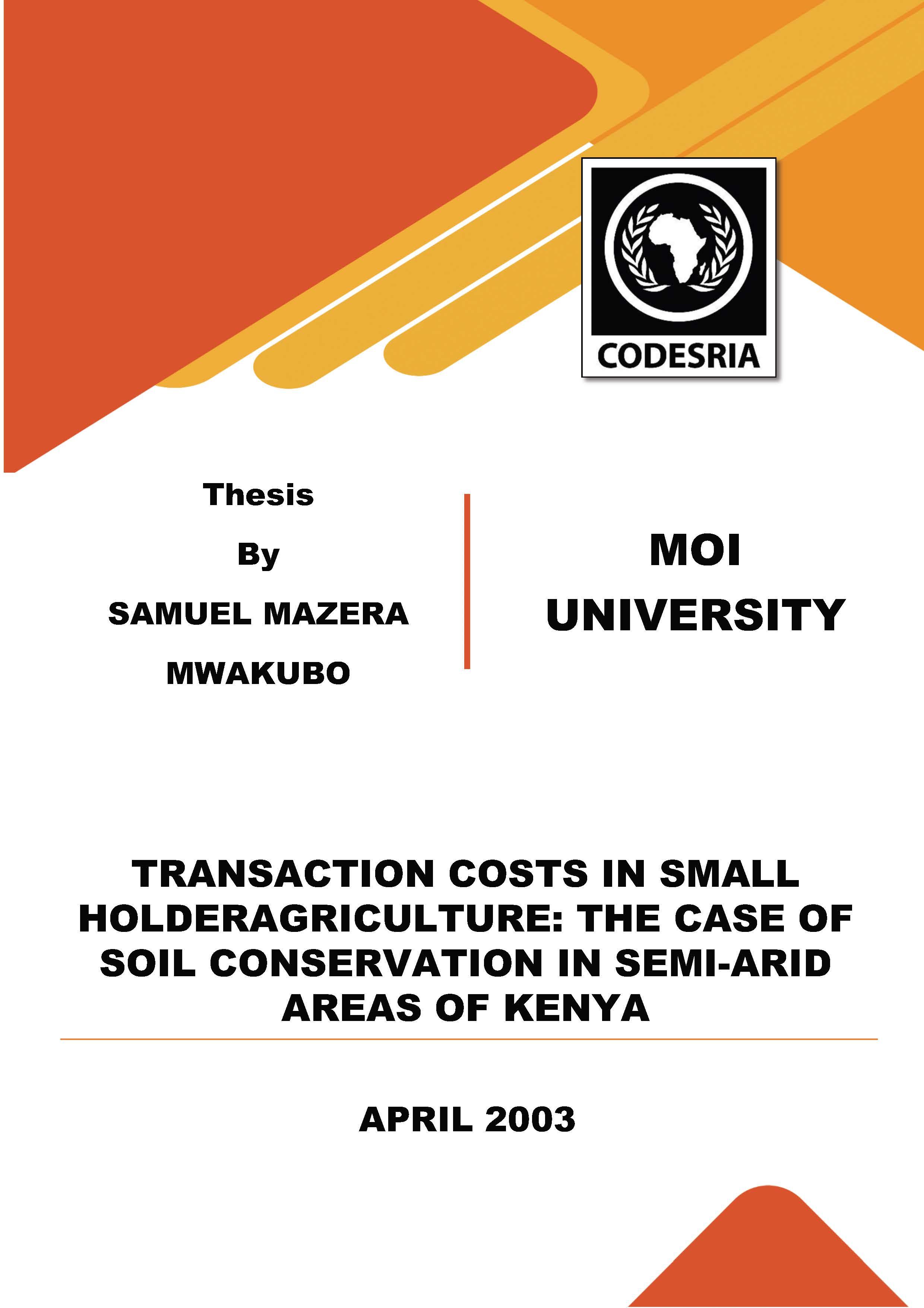TRANSACTION COSTS IN SMALL HOLDER AGRICULTURE: THE CASE OF SOIL CONSERVATION IN SEMI-ARID AREAS OF KENYA
Keywords:
TRANSACTION, HOLDER AGRICULTURE, SOIL, SEMI-ARID, KENYASynopsis
Marginal areas in Kenya that comprise about 80% of the total land area are ecologically vulnerable with very serious problems of soil erosion. A decline in agricultural productivity is the result, accompanied by serious household food insecurity. As more people immigrate to these areas coupled with births, the problem is bound to get worse.
Nevertheless, these areas can be productive iffarmers make investments on their land Investments into soil and water conservation include terraces, trees, cattle, manure, fertiliser, equipment, wells, dams and other infrastructure. Investments into soil and water conservation may be undertaken when sufficient returns are expected_ These returns, in particular monetary returns, can be related to many factors, but are always influenced by transaction costs of market exchange which subsequently determine the level of access to input and output markets.
Essentially the research seeks to determine the influence of transaction costs on soil conservation in smallholder agriculture and their role and impact on sustainable resource management and agricultural productivity.
A multi-stage random sampling was used to collect cross-sectional data from farming households using a structured questionnaire in Machakos and Kitui Districts. Besides descriptive statistics, econometric analysis using Three Stage Least Squares (3SLS) estimated with the help ofHeckman Two Stage procedure was used to test whether transaction costs to the market was a binding constraint to soi! and water conservation, resource use and agricultural productivity. A Cobb-Douglas type of regression function was also used to investigate how farmers respond to the net benefits of soil conservation measures. Further, a dynamic simultaneous agricultural household mode! was used to model households as both production and consumption centres.
The study findings show clearly that transaction costs reduce manure and fertiliser use of farming households as well as and more importantly soi! conservation investments including net benefits of soil conservation investments. The results further show that transaction costs increase labour use. This apparent anomaly can be explained as household' s response to increased transaction costs and the need to meet subsistence needs (i.e. food security). Simulation of the agricultural household mode] of a 10% reduction in transaction costs show that soi! conservation investments increase though with a lower magnitude depending on resource endowments of farming households.
Thus generic measures that can significantly reduce transaction costs such as improvement of road infrastructure; formation of co-operatives, marketing producer groups, and self-help groups serve as viable policy areas in order to induce investments in soil conservation measures on a large scale, with consequent sustainability of farming systems. Other likely policy measures include revamping extension service, improving property rights, and taking into account mobilization of social capital as part of the policy package towards sustainable agriculture.
Downloads
References
Adesina A.A. and MM. Zinnah. (1993), "Technology Characteristics, Fanner Perceptions and Adoption Decisions: A Tobit Mode! Application in Sierra Leone", Agricultural Economies, 9, 297-311.
Admassie, Y., L.L Mwarasombo, and P. Mbogo (1998). The sustainability of the catchment approach-induced measures and activities. Nairobi: National Soil and Water Conservation Programme, Ministiy of Agriculture.
Ahn, C.Y., L. Singh, and L. Squire. (1981). "The mode! ofan agricultural household in a multi-crop economy: The case ofKorea." Review of Economies and Statistics 63:520- 525.
Akerlof, G. ( 1970). "The Market for Lemons: Quality Uncertainty and the Market Mechanism". Quarterly Journal of Economies, 84(3), pp. 488-500.
Alberta, Th., H. van Keulen, N.G. Seligman & C.T. de Wit (1992). Foodfrom dry lands. An integrated approach to planning of agricultural development. Kluwer Academic Press. pp.211.
Anderson, D.M. (1984). 'Depression, dustbowl, demography and drought: the colonial state and soil conservation in East Africa during the 1930s'. African Affairs, 83(332), 321-343.
Anderson, J and J. Thampillai .(1990). Soi! conservation in developing countries: projects and policy intervention. Policy and research series No.8. Washington, D.C.: The World Bank: Anim, F.D.K. (1999). "A note on the Adoption of soi! Conservation Measures in the Northern Province of South Africa". Jaumal of agricultural Economies. Vol (50).No2: pp336-345
Antle, J.M. (1987). "Econometric estimation ofproducers' risk attitudes." American Journal of Agricultural Economies (69): 509-522.
Antle, J.M. (1989). "Nonstructural risk attitude estimation." American Journal of Agricultural Economies (71 ): 774-783.
Antle, J.M. and C.C. Crissman. (1990). "Risk, efficiency, and the adoption of modern crop varieties: evidence from the Philippines". Economie Development and Cultural Change, 38:517-537.






